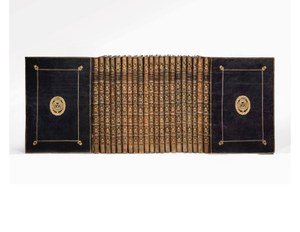Estimate
EUR 400,000 – EUR 600,000.
AN EXCEPTIONAL COPY BOUND IN DARK BLUE MOROCCO WITH THE ROYAL COAT OF ARMS: THE MOST COMPLETE AND DESIRABLE EVER OFFERED.
The "Cabinet du Roi" refers to the engraved plates commissioned during the reign of Louis XIV and the works printed from them. This triumphal procession of paper was intended to celebrate the scientific advances, artistic achievements and military exploits of the monarch and his reign. Jean-Baptiste Colbert, Controller of Finances, played a key role to its realization. He early understood that "the print, a work of art but also a multiple signifier, had its rightful place in an ambitious cultural policy aimed at making the world and posterity aware of the splendours of the reign of Louis XIV: through its impact, it was a perfect propaganda tool" (M. Grivel, Graver pour le roi, p. 21).
To execute this masterpiece, nothing was left to chance: the best engravers, burinists and aquafortists were called in, only quality paper and ink were used, and the copies were bound in gilt morocco. It was contrasting the formal austerity often favoured by booksellers of the period. The Cabinet du roi was the leather and paper embodiment of the splendours of the reign of Louis XIV. Once printed and bound, copies were frequently offered to princes and great lords, ecclesiastics, magistrates, scholars and, of course, ambassadors who, by virtue of their position, helped the plates to be distributed to all the courts of Europe, and indeed the whole world, as far afield as Constantinople, Asia and Persia.
During the 17th century, these thematically grouped plates were published in large folio volumes "covered in incarnate morocco". The idea of a "catalogue" or "cabinet" was not yet present in the minds of the genial instigators of this formidable publishing and artistic enterprise. The end of the reign of Louis XIV, marked by great financial difficulties, brought the distribution of engravings from the royal collections to a halt. The light of the Sun King no longer shone as brightly.
Nevertheless, successive guards of the king's library set about inventorying the stocks of prints and replenishing those that were missing, as well as expanding the collections. The Abbé de Louvois thus ordered the purchase of some of Van der Meulen's plates and those of Les Batailles by Sébastien de Pontault de Beaulieu.
During the Regency, Abbé Bignon, the King's librarian from 1719 onwards, completely redesigned and re-edited what was now called Le Cabinet du Roi. He condensed the palaces and houses, collections, festivals and royal conquests into 23 volumes. The scientific and cartographic volumes were removed. Starting in 1723, 50 copies were printed on large eagle paper and published a catalogue (reprinted in 1743).
Of these 50 copies, no one knows how many have survived. It is certain that the copy presented here, comprising 21 of the 23 volumes, superbly bound in blue morocco with the royal coat of arms, is the finest and most desirable in private hands.
21 large folio volumes (625 x 450 mm). illustrations: 794 engravings on 666 leaves. Contemporary binding probably exectued by the royal binder workshops: dark blue morocco, double framed with triple gilt fillet, gilt crowned cipher in the corners, royal gilt coat of arms in the centre of the boards, spine ribbed and decorated with crowned cipher and fleur-de-lys, gilt lettering, gilt edges.Christie’s



